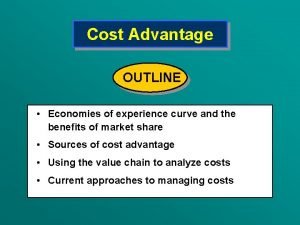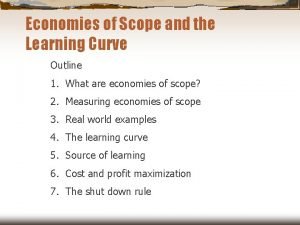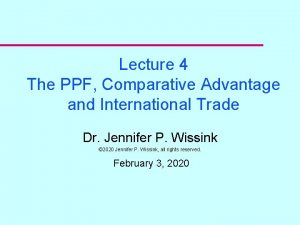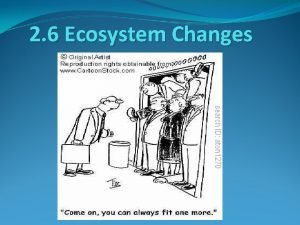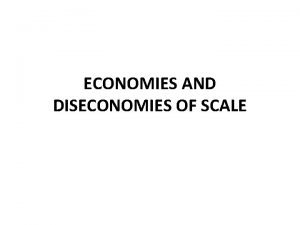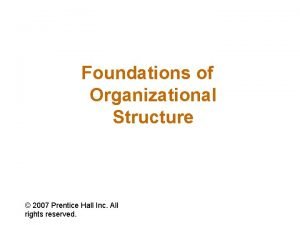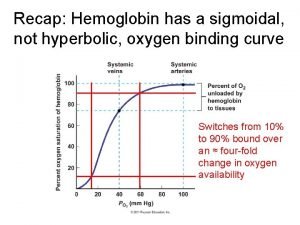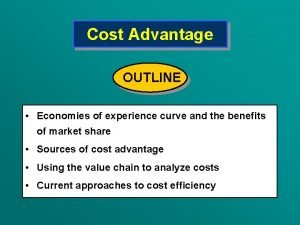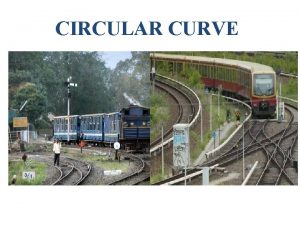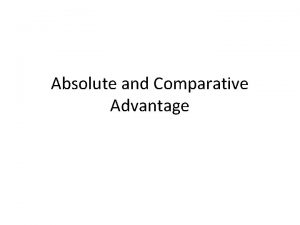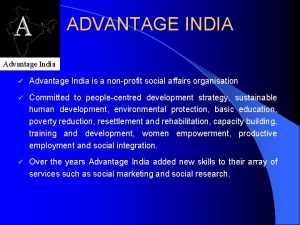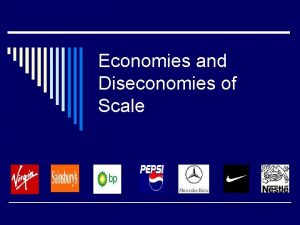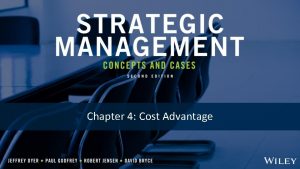Cost Advantage OUTLINE Economies of experience curve and














- Slides: 14

Cost Advantage OUTLINE • Economies of experience curve and the benefits of market share • Sources of cost advantage • Using the value chain to analyze costs • Current approaches to managing costs

The Experience Curve The “Law of Experience” 1992 1994 Cost per unit of output (in real $) The unit cost value added to a standard product declines by a constant % (typically 2030%) each time cumulative output doubles. 1996 1998 2000 Cumulative Output 2002 2004

Examples of Experience Curves 75% 100 K 200 K 500 K 1, 000 K Accumulated unit production (millions) UK refrigerators, 1957 -71 Price Index 50 100 200 300 1960 Yen 15 K 20 K 30 K Japanese clocks & watches, 1962 -72 70% slope 5 10 50 Accumulated units (millions)

The Importance of Market Share If all firms in an industry have the same experience curve, then: Change in relative costs over time = f (relative market share) ROS (%) -2 0 5 10 This supported by PIMS data: 0 -10 10 -20 20 -30 30 -40 Market Share (%) over 40 BUT: - Association does not imply causation - Costs of acquiring market share offset the returns to market share

Drivers of Cost Advantage ECONOMIES OF SCALE ECONOMIES OF LEARNING PRODUCTION TECHNIQUES PRODUCT DESIGN INPUT COSTS • Indivisiblities • Specialization and division of labor • Increased dexterity • Improved organizational routines • Process innovation • Reengineering business processes • Standardizing designs & components • Design for manufacture • Location advantages • Ownership of low-cost inputs • Non-union labor • Bargaining power CAPACITY UTILIZATION • Ratio of fixed to variable costs • Speed of capacity adjustment RESIDUAL EFFICIENCY • Organizational slack; Motivation & culture; Managerial efficiency

Economies of Scale: The Long-Run Cost Curve for a Plant Sources of scale economies: - technical input/output relationships - indivisibilities - specialization Cost per unit of output Minimum Efficient Plant Size Units of output period

The Costs Developing New Car Models (including plant tooling) Ford Mondeo/ Contour GM Saturn Ford Taurus (1996 model) Ford Escort (new model 1996) Renault Clio (1999 model) Chrysler Neon Honda Accord (1997 model) BMW Mini Rolls Royce Phantom (2003 model) $ billion 6 5 2. 8 2 1. 3 0. 6 0. 5 0. 3

Scale Economies in Advertising: U. S. Soft Drinks Advertising Expenditure ($ per case) 0. 02 0. 05 0. 10 0. 15 0. 20 Despite the massive advertising budgets of brand leaders Coke and Pepsi, smaller brands which incur the highest advertising costs per unit of sales Schweppes SF Dr. Pepper Diet 7 -Up Tab Diet Pepsi Diet Rite Fresca Seven Up Dr. Pepper Sprite Pepsi 10 20 50 100 200 500 Annual sales volume (millions of cases) Coke 1, 000

Cost Advantage in Short-Haul Passenger Air Transport Costs per Available Seat-Mile (1993) Southwest Airlines (cents) Wages and benefits 2. 4 Fuel and oil 1. 1 Aircraft ownership 0. 7 Aircraft maintenance 0. 6 Commissions on ticket sales 0. 5 Advertising 0. 2 Food and beverage 0. 0 Other 1. 7 Total 7. 2 United Airlines (cents) 3. 5 1. 1 0. 8 0. 3 1. 0 0. 2 0. 5 3. 1 10. 5

Key Stages in Applying the Value Chain to Cost Analysis: The Case of Automobile Manufacture STAGE 1. IDENTIFY THE PRINCIPLE ACTIVITIES PURCHASING PARTS INVENTORIES R&D TESTING, COMPONENT ASSEMBLY DESIGN QUALITY MFR ENGNRNG CONTROL GOODS INVENTORIES SALES DISTRI- DEALER & & BUTION CUSTOMER MKITG SUPPORT STAGE 2. ALLOCATE TOTAL COSTS

Applying the Value Chain to Cost Analysis (continued) STAGE 3. IDENTIFY COST DRIVERS PURCHASING PARTS INVENTORIES --Plant scale for each component -- Process technology -- Plant location -- Run length -- Capacity utilization -- Level of quality targets -- Frequency of defects R&D COMPONENT ASSEMBLY TESTING, DESIGN QUALITY MFR ENGNRNG CONTROL Prices paid --Size of commitment depend on: --Productivity of -- Order size R&D/design --Purchases per --No. & frequency of new supplier models -- Bargaining power -- Supplier location GOODS INVENTORIES -- Plant scale -- Flexibility of production -- No. of models per plant -- Degree of automation -- Sales / model -- Wage levels -- Capacity utilization -- No. of dealers -- Sales / dealer -- Level of dealer support -- Frequency of defects under warranty SALES & MKITG DISTRI- DEALER & BUTION CUSTOMER SUPPORT --Cyclicality & predictability of sales --Customers’ willingness to wait

Applying the Value Chain to Cost Analysis (continued) STAGE 4. IDENTIFY LINKAGES Consolidation of orders to increase discounts, increases inventories PRCHSNG PARTS INVNTRS R&D DESIGN Designing different models around common components and platforms reduces manufacturing costs COMPONENT MFR Higher quality parts and materials reduces costs of defects at later stages ASSMBY TESTING GOODS QUALITY INV SALES DSTRBTN DLR MKTG CTMR Higher quality in manufacturing reduces warranty costs STAGE 5. RECCOMENDATIONS FOR COST REDUCTION

Dynamic vs. Static Approaches to Manufacturing DYNAMIC Artisan mode: PRODUCTION SYSTEM Scientific Management Mode: - problem solving - quest for “one best way” - employee knowledge creation - people matched to tasks - employee control over product - incentives and penalties to - product and customer ensure conformity to objectives orientation - planning and control by staff - continuous incremental MANAGEMENT OF TECHNOLOGY STATIC - science driven improvement - focused around corporate R&D - market needs pull technology departments - product and process innovation- emphasis on product Innovation - teamwork and cross-functional and big projects collaboration

Recent Approaches to Cost Reduction CORPORATE RESTRUCTURING BUSINESS PROCESS REENGINEERING Dramatic changes in strategy and structure to adjust to the business conditions of the 1990’s Key elements: • Plant closures • Outsourcing • Delayering and cuts in administrative staff The fundamental rethinking and radical redesign of business processes to achieve dynamic improvements in performance. e. g. : • Several jobs combined into one • Steps of a process combined in natural order • Minimizing steps, controls, and reconciliation • Use case managers as single points of contact • Hybrid centralization/ decentralization
 Experience curve economies
Experience curve economies Learning curve and economies of scope
Learning curve and economies of scope Direct experience vs indirect experience
Direct experience vs indirect experience Imprint definition psychology
Imprint definition psychology Early experience vs later experience debate
Early experience vs later experience debate Comparative advantage vs absolute advantage
Comparative advantage vs absolute advantage Actual mechanical advantage vs ideal mechanical advantage
Actual mechanical advantage vs ideal mechanical advantage S curve and j curve
S curve and j curve J curve vs s curve
J curve vs s curve How to make a sandwich paragraph
How to make a sandwich paragraph Define diseconomies of scale
Define diseconomies of scale Economies and diseconomies of work specialization
Economies and diseconomies of work specialization Cipd experience assessment
Cipd experience assessment Sigmoidal and hyperbolic curve
Sigmoidal and hyperbolic curve Enter bolus exit balance
Enter bolus exit balance
